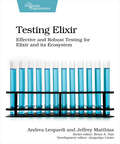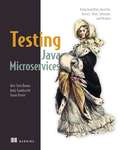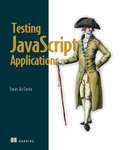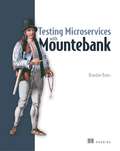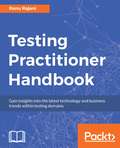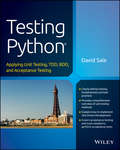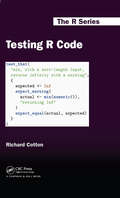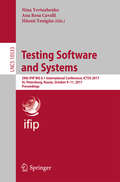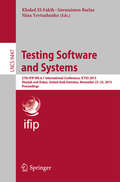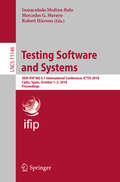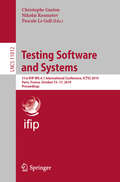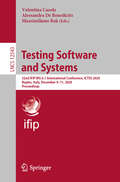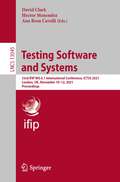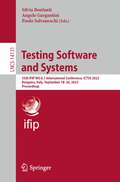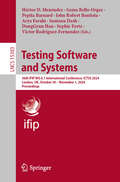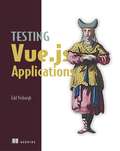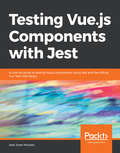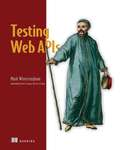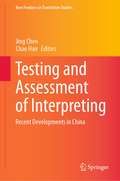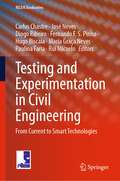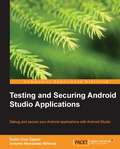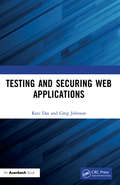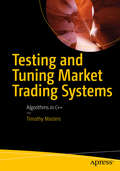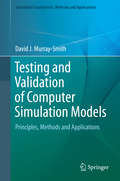- Table View
- List View
Testing Elixir: Effective And Robust Testing For Elixir And Its Ecosystem
by Andrea Leopardi Jeffrey MatthiasElixir offers new paradigms, and challenges you to test in unconventional ways. Start with ExUnit: almost everything you need to write tests covering all levels of detail, from unit to integration, but only if you know how to use it to the fullest - we'll show you how. Explore testing Elixir-specific challenges such as OTP-based modules, asynchronous code, Ecto-based applications, and Phoenix applications. Explore new tools like Mox for mocks and StreamData for property-based testing. Armed with this knowledge, you can create test suites that add value to your production cycle and guard you from regressions. Write Elixir tests that you can be proud of. Dive into Elixir's test philosophy and gain mastery over the terminology and concepts that underlie good tests. Create and structure a comprehensive ExUnit test suite, starting from the basics, and build comprehensive test coverage that will provide safety for refactoring and confidence that your code performs as designed. Use tests to make your software more reliable and fault tolerant. Explore the basic tool set provided by ExUnit and Mix to write and organize your test suite. Test code built around different OTP functionality. Isolate your code through dependency injection and by using Mox. Write comprehensive tests for Ecto projects, covering Ecto as a database tool as well as a standalone data validation tool. Test Phoenix channels from end to end, including authentication and joining topics. Write Phoenix controller tests and understand the concepts of integration testing in Elixir. Learn property-based testing with StreamData from the author who wrote the library. Code with high confidence that you are getting the most out of your test suite, with the right tools that make testing your code a pleasure and a valuable part of your development cycle. What You Need: To get the most out of this book, you will need to have installed Elixir 1.8 or later and Erlang/OTP 21 or later. In order to complete the relevant chapters, you will also need Ecto 3.1 or later, EctoSQL 3.1 or later and Phoenix 1.3 or later.
Testing Java Microservices: Using Arquillian, Hoverfly, AssertJ, JUnit, Selenium, and Mockito
by Jason Porter Alex Soto Andrew GumbrechtSummaryTesting Java Microservices teaches you to implement unit and integration tests for microservice systems running on the JVM. You'll work with a microservice environment built using Java EE, WildFly Swarm, and Docker. You'll learn how to increase your test coverage and productivity, and gain confidence that your system will work as you expect.Purchase of the print book includes a free eBook in PDF, Kindle, and ePub formats from Manning Publications.About the TechnologyMicroservice applications present special testing challenges. Even simple services need to handle unpredictable loads, and distributed message-based designs pose unique security and performance concerns. These challenges increase when you throw in asynchronous communication and containers.About the BookTesting Java Microservices teaches you to implement unit and integration tests for microservice systems running on the JVM. You'll work with a microservice environment built using Java EE, WildFly Swarm, and Docker. You'll advance from writing simple unit tests for individual services to more-advanced practices like chaos or integration tests. As you move towards a continuous-delivery pipeline, you'll also master live system testing using technologies like the Arquillian, Wiremock, and Mockito frameworks, along with techniques like contract testing and over-the-wire service virtualization. Master these microservice-specific practices and tools and you'll greatly increase your test coverage and productivity, and gain confidence that your system will work as you expect.What's InsideTest automationIntegration testing microservice systemsTesting container-centric systemsService virtualizationAbout the ReaderWritten for Java developers familiar with Java EE, EE4J, Spring, or Spring Boot.About the AuthorsAlex Soto Bueno and Jason Porter are Arquillian team members. Andy Gumbrecht is an Apache TomEE developer and PMC. They all have extensive enterprise-testing experience.Table of ContentsAn introduction to microservicesApplication under testUnit-testing microservicesComponent-testing microservicesIntegration-testing microservicesContract testsEnd-to-end testingDocker and testingService virtualizationContinuous delivery in microservices
Testing JavaScript Applications
by Lucas Fernandes da CostaTesting JavaScript Applications teaches you how to implement an automated testing plan for JavaScript-based web applications.Summary Automated testing will help you write high-quality software in less time, with more confidence, fewer bugs, and without constant manual oversight. Testing JavaScript Applications is a guide to building a comprehensive and reliable JS application testing suite, covering both how to write tests and how JS testing tools work under the hood. You&’ll learn from Lucas de Costa, a core contributor to popular JS testing libraries, as he shares a quality mindset for making testing decisions that deliver a real contribution to your business. You&’ll benefit from informative explanations and diagrams, easily-transferable code samples, and useful tips on using the latest and most consolidated libraries and frameworks of the JavaScript ecosystem. Purchase of the print book includes a free eBook in PDF, Kindle, and ePub formats from Manning Publications. About the technology Automated testing is essential to delivering good JavaScript applications every time. A complete testing strategy needs to cover functions in isolation, integration between different parts of your code, and correctness from the end user&’s perspective. This book will teach you how to deliver reliable software quickly and confidently. About the book Testing JavaScript Applications teaches you how to implement an automated testing plan for JavaScript-based web applications. It describes practical testing strategies, covers useful tools and libraries, and explains how to foster a culture of quality. In this clearly-written, example-rich book, you&’ll explore approaches for both backend and frontend applications and learn how to validate your software much more quickly and reliably. What's inside Unit, end-to-end, and integration testing Managing test cost and complexity Practicing test-driven development Dealing with external dependencies Tools like like Jest and Cypress About the reader For junior JavaScript developers. About the author Lucas da Costa is a core maintainer of Chai and Sinon.JS, two of the most popular testing tools in the JavaScript ecosystem, and contributed to numerous other open-source projects, including Jest. Table of Contents PART 1 - TESTING JAVASCRIPT APPLICATIONS 1 An introduction to automated testing 2 What to test and when? Part 2 - WRITING TESTS 3 Testing techniques 4 Testing backend applications 5 Advanced backend testing techniques 6 Testing frontend applications 7 The React testing ecosystem 8 Testing React applications 9 Test-driven development 10 UI-based end-to-end testing 11 Writing UI-based end-to-end tests PART 3 - BUSINESS IMPACT 12 Continuous integration and continuous delivery 13 A culture of quality
Testing Microservices with Mountebank
by Brandon ByarsSummaryTesting Microservices with Mountebank is your guide to the ins and outs of testing microservices with service virtualization. The book offers unique insights into microservices application design and state-of-the-art testing practices that will deepen your microservices skills and improve your applications.Purchase of the print book includes a free eBook in PDF, Kindle, and ePub formats from Manning Publications.About the TechnologyEven if you lab test each service in isolation, it's challenging—and potentially dangerous—to test a live microservices system that's changing and growing. Fortunately, you can use Mountebank to "imitate" the components of a distributed microservices application to give you a good approximation of the runtime conditions as you test individual services.About the BookTesting Microservices with Mountebank introduces the powerful practice of service virtualization. In it, author Brandon Byars, Mountebank's creator, offers unique insights into microservices application design and state-of-the-art testing practices. You'll expand your understanding of microservices as you work with Mountebank's imposters, responses, behaviors, and programmability. By mastering the powerful testing techniques in this unique book, your microservices skills will deepen and your applications will improve. For real.What's insideThe core concepts of service virtualizationTesting using canned responsesProgramming MountebankPerformance testingAbout the ReaderWritten for developers familiar with SOA or microservices systems.About the AuthorBrandon Byars is the author and chief maintainer of Mountebank and a principal consultant at ThoughtWorks.Table of ContentsPART 1 - FIRST STEPSTesting microservicesTaking mountebank for a test drivePART 2 - USING MOUNTEBANKTesting using canned responsesUsing predicates to send different responsesAdding record/replay behaviorProgramming mountebankAdding behaviorsProtocolsPART 3 - CLOSING THE LOOPMountebank and continuous deliveryPerformance testing with mountebank
Testing Practitioner Handbook
by Renu RajaniGain insights into the latest technology and business trends within testing domains About This Book • This book covers the latest trends that every Testing and QA professional should keep up-to-date with given the advancements in digital technologies. • Master cutting-edge testing techniques for emerging areas such as IOT, Machine Learning, Cognitive. • Best practices for Testing and Quality Assurance within several industry domains. Who This Book Is For This book is targeted at those working in the QA and Testing areas. The book does not cover testing basics, which QA professional are already familiar with—for example, writing a test plan or test case, and so on. What You Will Learn • Understand the TCOE model, managed services, the structure of testing in Agile/DevOps engagements, factory models, and crowdsourcing • Implement testing processes, practices, and automation tools in the Agile/DevOps life cycle • Adapt to current technologies in social media, mobile, analytics and the Cloud • Leverage cognitive intelligence/machine-learning, robotics, and the Internet of Things in testing • How key industries/domains (consumer products and retail, energy and utilities, healthcare, telecom, and automotive) adapt to digital transformation • Future directions for the QA industry, consulting careers, testing profession, and professionals In Detail The book is based on the author`s experience in leading and transforming large test engagements and architecting solutions for customer testing requirements/bids/problem areas. It targets the testing practitioner population and provides them with a single go-to place to find perspectives, practices, trends, tools, and solutions to test applications as they face the evolving digital world. This book is divided into five parts where each part explores different aspects of testing in the real world. The first module explains the various testing engagement models. You will then learn how to efficiently test code in different life cycles. The book discusses the different aspects of Quality Analysis consideration while testing social media, mobile, analytics, and the Cloud. In the last module, you will learn about futuristic technologies to test software. By the end of the book, you will understand the latest business and IT trends in digital transformation and learn the best practices to adopt for business assurance. Style and approach This book is a compilation of the latest business and IT trends in digital transformation & Tools and Best Practices that QA professionals need to adopt for business assurance.
Testing Python
by David SaleFundamental testing methodologies applied to the popular Pythonlanguage Testing Python; Applying Unit Testing, TDD, BDD andAcceptance Testing is the most comprehensive book available ontesting for one of the top software programming languages in theworld. Python is a natural choice for new and experienceddevelopers, and this hands-on resource is a much needed guide toenterprise-level testing development methodologies. The book willshow you why Unit Testing and TDD can lead to cleaner, moreflexible programs.Unit Testing and Test-Driven Development (TDD) are increasinglymust-have skills for software developers, no matter what languagethey work in. In enterprise settings, it's critical for developersto ensure they always have working code, and that's what makestesting methodologies so attractive. This book will teach you themost widely used testing strategies and will introduce to you tostill others, covering performance testing, continuous testing, andmore.Learn Unit Testing and TDD--important developmentmethodologies that lie at the heart of Agile developmentEnhance your ability to work with Python to develop powerful,flexible applications with clean codeDraw on the expertise of author David Sale, a leading UKdeveloper and tech commentatorGet ahead of the crowd by mastering the underappreciated worldof Python testingKnowledge of software testing in Python could set you apart fromPython developers using outmoded methodologies. Python is a naturalfit for TDD and Testing Python is a must-read text foranyone who wants to develop expertise in Python programming.
Testing R Code (Chapman & Hall/CRC The R Series)
by Richard CottonLearn how to write R code with fewer bugs. The problem with programming is that you are always one typo away from writing something silly. Likewise with data analysis, a small mistake in your model can lead to a big mistake in your results. Combining the two disciplines means that it is all too easy for a missed minus sign to generate a false prediction that you don’t spot until it’s too late. Testing is the only way to be sure that your code, and your results, are correct. Testing R Code teaches you how to perform development-time testing using the testthat package, allowing you to ensure that your code works as intended. The book also teaches run-time testing using the assertive package; enabling your users to correctly run your code. After beginning with an introduction to testing in R, the book explores more advanced cases such as integrating tests into R packages; testing code that accesses databases; testing C++ code with Rcpp; and testing graphics. Each topic is explained with real-world examples, and has accompanying exercises for readers to practise their skills — only a small amount of experience with R is needed to get started!
Testing Software and Systems
by Nina Yevtushenko Ana Rosa Cavalli Hüsnü YenigünThis book constitutes the refereed proceedings of the 29th IFIP WG 6. 1 International Conference on Testing Software and Systems ICTSS 2017, held in St. Petersburg, Russia, in October 2017. The 18 full papers and 4 short papers presented were carefully reviewed and selected from 41 submissions. The topics of the volume cover model based testing; test derivation and monitoring; fault localization and system testing including real time systems.
Testing Software and Systems
by Franz Wotawa Mihai Nica Natalia KushikThis book constitutes the refereed proceedings of the 278th IFIP WG 6. 1 International Conference on Testing Software and Systems, ICTSS 2016, held in Graz, Austria, in October 2016. The 12 revised full papers and 6 short papers presented were carefully reviewed and selected from 41 submissions. The papers are organized in topical sections on testing methodologies, heuristics and non-determinism in testing, practical applications, and short contributions.
Testing Software and Systems
by Nina Yevtushenko Khaled El-Fakih Gerassimos BarlasThis book constitutes the refereed proceedings of the 27th IFIP WG 6. 1 International Conference on Testing Software and Systems, ICTSS 2015, held in Sharjah and Dubai, United Arab Emirates, in November 2015. The 14 revised full papers and 4 short papers presented were carefully reviewed and selected from 42 submissions. The papers are organized in topical sections on model based testing, test derivation methods, monitoring and fault localization, model and system testing, and real-time systems.
Testing Software and Systems: 30th IFIP WG 6.1 International Conference, ICTSS 2018, Cádiz, Spain, October 1-3, 2018, Proceedings (Lecture Notes in Computer Science #11146)
by Inmaculada Medina-Bulo Mercedes G. Merayo Robert HieronsThis book constitutes the refereed proceedings of the 30th IFIP WG 6.1 International Conference on Testing Software and Systems, ICTSS 2018, held in Cádiz, Spain, in October 2018. The 8 regular and 6 short papers presented were carefully reviewed and selected from 29 submissions. ICTSS is a series of international conferences addressing the conceptual, theoretic, and practical problems of testing software systems, including communication protocols, services, distributed platforms, middleware, embedded- and cyber-physical-systems, and security infrastructures.
Testing Software and Systems: 31st IFIP WG 6.1 International Conference, ICTSS 2019, Paris, France, October 15–17, 2019, Proceedings (Lecture Notes in Computer Science #11812)
by Nikolai Kosmatov Christophe Gaston Pascale Le GallThis book constitutes the refereed proceedings of the 31st IFIP WG 6.1 International Conference on Testing Software and Systems, ICTSS 2019, held in Paris, France, in October 2019. The 14 regular papers and 3 short papers presented were carefully reviewed and selected from 30 submissions. This year also included an additional industrial paper. ICTSS is a series of international conferences addressing the conceptual, theoretic, and practical problems of testing software systems, including communication protocols, services, distributed platforms, middleware, embedded and cyber-physical systems, and security infrastructures.
Testing Software and Systems: 32nd IFIP WG 6.1 International Conference, ICTSS 2020, Naples, Italy, December 9–11, 2020, Proceedings (Lecture Notes in Computer Science #12543)
by Valentina Casola Alessandra De Benedictis Massimiliano RakThis book constitutes the refereed proceedings of the 32nd IFIP WG 6.1 International Conference on Testing Software and Systems, ICTSS 2020, which was supposed to be held in Naples, Italy, in December 2020, but was held virtually due to the COVID-19 pandemic.The 17 regular papers and 4 short papers presented were carefully reviewed and selected from 43 submissions. ICTSS is a series of international conferences addressing the conceptual, theoretic, and practical problems of testing software systems, including communication protocols, services, distributed platforms, middleware, embedded and cyber-physical systems, and security infrastructures. The papers are organized in the topical sections named: model-based testing; security testing; testing methods and applications; testing methods and automation; and short contributions.
Testing Software and Systems: 33rd IFIP WG 6.1 International Conference, ICTSS 2021, London, UK, November 10–12, 2021, Proceedings (Lecture Notes in Computer Science #13045)
by David Clark Ana Rosa Cavalli Hector MenendezThis book constitutes the refereed proceedings of the 33rd IFIP WG 6.1 International Conference on Testing Software and Systems, ICTSS 2021, which was supposed to be held in London, UK, but was held virtually due to the COVID-19 pandemic. The 10 regular papers and 7 short papers presented were carefully reviewed and selected from 36 submissions. Additionally, the volume includes 6 project reports. The papers are divided into the following topical subheadings: Finite State Machine-based Testing; Test Generation and Selection; AI-based Techniques; Use Cases; Project Reports.
Testing Software and Systems: 35th IFIP WG 6.1 International Conference, ICTSS 2023, Bergamo, Italy, September 18–20, 2023, Proceedings (Lecture Notes in Computer Science #14131)
by Angelo Gargantini Silvia Bonfanti Paolo SalvaneschiThis book constitutes the refereed proceedings of the 35th IFIP WG 6.1 International Conference on Testing Software and Systems, ICTSS 2023, held in Bergamo, Italy, during September 18-20, 2023.The 13 full papers presented together with 6 short papers and one journal paper were carefully reviewed and selected from 56 submissions. The conference focuses on Test Case Generation; Test Automation and Design; Model Based Testing; and AI and Smart Contracts Testing.
Testing Software and Systems: 36th IFIP WG 6.1 International Conference, ICTSS 2024, London, UK, October 30 – November 1, 2024, Proceedings (Lecture Notes in Computer Science #15383)
by Héctor D. Menéndez Gema Bello-Orgaz Pepita Barnard John Robert Bautista Arya Farahi Santanu Dash DongGyun Han Sophie Fortz Victor Rodriguez-FernandezThis book constitutes the refereed proceedings of the 36th IFIP WG 6.1 International Conference on Testing Software and Systems, ICTSS 2024, held in London, UK, during October 30–November 1, 2024. The 17 full papers and 5 short papers included in this book were carefully reviewed and selected from 40 submissions. They were organized in topical sections as follows: Best Paper Award; Industry and Challenge Tracks; Mutation Testing and Code Generation; Advancing Code Vulnerability Detection; Short Papers; Tutorial; Journal First; Health Track; Innovations in Software Testing and AI Compliance; Improving Software Testing Reliability and Advancements in Testing Methodologies.
Testing Vue.js Applications
by Edd YerburghSummaryTesting Vue.js Applications is a comprehensive guide to testing Vue components, methods, events, and output. Author Edd Yerburgh, creator of the Vue testing utility, explains the best testing practices in Vue along with an evergreen methodology that applies to any web dev process.Purchase of the print book includes a free eBook in PDF, Kindle, and ePub formats from Manning Publications.About the TechnologyWeb developers who use the Vue framework love its reliability, speed, small footprint, and versatility. Vue's component-based approach and use of DOM methods require you to adapt your app-testing practices. Learning Vue-specific testing tools and strategies will ensure your apps run like they should.About the BookWith Testing Vue.js Applications, you'll discover effective testing methods for Vue applications. You'll enjoy author Edd Yerburgh's engaging style and fun real-world examples as you learn to use the Jest framework to run tests for a Hacker News application built with Vue, Vuex, and Vue Router. This comprehensive guide teaches the best testing practices in Vue along with an evergreen methodology that applies to any web dev process.What's insideUnit tests, snapshot tests, and end-to-end testsWriting unit tests for Vue componentsWriting tests for Vue mixins, Vuex, and Vue RouterAdvanced testing techniques, like mockingAbout the ReaderWritten for Vue developers at any level.About the AuthorEdd Yerburgh is a JavaScript developer and Vue core team member. He's the main author of the Vue Test Utils library and is passionate about open source tooling for testing component-based applications.Table of ContentsIntroduction to testing Vue applicationsCreating your first testTesting rendered component outputTesting component methodsTesting eventsUnderstanding VuexTesting VuexOrganizing tests with factory functionsUnderstanding Vue RouterTesting Vue RouterTesting mixins and filtersWriting snapshot testsTesting server-side renderingWriting end-to-end testsAPPENDIXESA - Setting up your environmentB - Running the production buildC - Exercise answers
Testing Vue.js Components with Jest: A concise guide to testing Vue.js components using Jest and the official Vue Test Utils library
by Alex Jover MoralesUnit test your Vue.js components with this fully-featured JavaScript testing framework Key Features Understand the various testing styles and their purpose Gain insight into how to test methods by avoiding dependencies Explore snapshot testing and its applications Book Description Unit testing in modern component-based JavaScript frameworks is not straightforward. You need a test suite that is reliable and runs quickly. Components are connected to one another, and the browser adds a layer of UI, which makes everything inter-dependent while we test components in isolation. Jest is a fully-featured JavaScript testing framework that will do all your work for you. This book shows you how to test Vue.js components easily and take advantage of the fully-featured Jest testing framework with the aid of practical examples. You'll learn the different testing styles and their structures. You'll also explore how your Vue.js components respond to various tests. You'll see how to apply techniques such as snapshot testing, shallow rendering, module dependency mocking, and module aliasing to make your tests smooth and clean. By the end of this book, you'll know all about testing your components by utilizing the features of Jest. What you will learn Set up a Vue-test project to get started with Jest Unit test your components using techniques such as shallow rendering Gain insights into how to test the reactive parts in the logic of the Vue.js components Explore how to test deeply rendered Vue.js components Perform easy and quick tests with module dependency mocking, module aliasing, and more Know-how and when to use snapshot testing Who this book is for If you are a programmer looking to make your development process smooth and bug-free, this is an ideal book for you. Prior knowledge and experience of JavaScript will help you quickly and easily grasp the concepts explained in this book.
Testing Web APIs
by Mark WinteringhamEnsure your web APIs are consistent and bug-free by implementing an automated testing process.In Testing Web APIs you will: Design and implement a web API testing strategy Set up a test automation suite Learn contract testing with Pact Facilitate collaborative discussions to test web API designs Perform exploratory tests Experiment safely in a downloadable API sandbox environment Testing Web APIs teaches you to plan and implement the perfect testing strategy for your web APIs. In it, you&’ll explore dozens of different testing activities to help you develop a custom testing regime for your projects. This practical book demystifies abstract strategic concepts by applying them to common API testing scenarios, revealing how these complex ideas work in the real world. You&’ll learn to take a risk-driven approach to API testing, and build a strategy that goes beyond the basics of code and requirements coverage. Your whole team will soon be involved in ensuring quality! About the technology Web APIs are the public face of your application, and they need to be perfect. Implementing an automated testing program is the best way to ensure that your web APIs are production ready. About the book Testing Web APIs is a unique and practical guide, from the initial design of your testing suite through techniques for documentation, implementation, and delivery of consistently excellent APIs. You&’ll see a wide range of testing techniques, from exploratory to live testing of production code, and how to save time with automation using industry-standard tools. This book helps take the hassle out of API testing. What's inside Design and implement a web API testing strategy Set up a test automation suite Contract testing with Pact Hands-on practice in the downloadable API sandbox About the reader For dedicated software QA and testers, or experienced developers. Examples in Java. About the author Mark Winteringham is the OpsBoss at Ministry of Testing, where he teaches many aspects of software testing. Table of Contents PART 1 THE VALUE OF WEB API TESTING 1 Why and how we test web APIs 2 Beginning our testing journey 3 Quality and risk PART 2 BEGINNING OUR TEST STRATEGY 4 Testing API designs 5 Exploratory testing APIs 6 Automating web API tests 7 Establishing and implementing a testing strategy PART 3 EXPANDING OUR TEST STRATEGY 8 Advanced web API automation 9 Contract testing 10 Performance testing 11 Security testing 12 Testing in production
Testing and Assessment of Interpreting: Recent Developments in China (New Frontiers in Translation Studies)
by Jing Chen Chao HanThis book highlights reliable, valid and practical testing and assessment of interpreting, presenting important developments in China, where testing and assessment have long been a major concern for interpreting educators and researchers, but have remained largely under-reported. The book not only offers theoretical insights into potential issues and problems undermining interpreting assessment, but also describes useful measurement models to address such concerns. Showcasing the latest Chinese research to create rubrics-referenced rating scales, enhance formative assessment practice, and explore (semi-)automated assessment, the book is a valuable resource for educators, trainers and researchers, enabling to gain a better understanding of interpreting testing and assessment as both a worthwhile endeavor and a promising research area.
Testing and Experimentation in Civil Engineering: From Current to Smart Technologies (RILEM Bookseries #41)
by José Neves Diogo Ribeiro Carlos Chastre Maria Graça Neves Paulina Faria Fernando F. S. Pinho Hugo Biscaia Rui MicaeloThis book gathers the peer-reviewed selected papers presented at the 3rd International Conference on Testing and Experimentation in Civil Engineering (TEST&E 2022), held in Almada, Portugal, on June 21-23, 2022. It showcases the role of smart technologies in all civil engineering areas, such as structures and construction, geotechnics and natural resources, hydraulics and water resources, transportation and communication networks. The conference topics encompass big data and advanced data processing systems, AI applications, virtual and augmented reality, 3D modeling and printing, digital twins, automation, sensing and detection technologies, inspection, monitoring and automatic damage identification, destructive and non-destructive testing, bio, nano and new materials, disaster risk reduction and emergency management. As such the book represents an invaluable, up-to-the-minute tool, and offers an important platform to engineers and architects.
Testing and Securing Android Studio Applications
by Belen Cruz Zapata Antonio Hernandez NinirolaIf you are a developer with some Android knowledge, but you do not know how to test your applications using Android Studio, this book will guide you. It is recommended that you are familiar with Android Studio IDE.
Testing and Securing Web Applications
by Greg Johnson Ravi DasWeb applications occupy a large space within the IT infrastructure of a business or a corporation. They simply just don’t touch a front end or a back end; today’s web apps impact just about every corner of it. Today’s web apps have become complex, which has made them a prime target for sophisticated cyberattacks. As a result, web apps must be literally tested from the inside and out in terms of security before they can be deployed and launched to the public for business transactions to occur. The primary objective of this book is to address those specific areas that require testing before a web app can be considered to be completely secure. The book specifically examines five key areas: Network security: This encompasses the various network components that are involved in order for the end user to access the particular web app from the server where it is stored at to where it is being transmitted to, whether it is a physical computer itself or a wireless device (such as a smartphone). Cryptography: This area includes not only securing the lines of network communications between the server upon which the web app is stored at and from where it is accessed from but also ensuring that all personally identifiable information (PII) that is stored remains in a ciphertext format and that its integrity remains intact while in transmission. Penetration testing: This involves literally breaking apart a Web app from the external environment and going inside of it, in order to discover all weaknesses and vulnerabilities and making sure that they are patched before the actual Web app is launched into a production state of operation. Threat hunting: This uses both skilled analysts and tools on the Web app and supporting infrastructure to continuously monitor the environment to find all security holes and gaps. The Dark Web: This is that part of the Internet that is not openly visible to the public. As its name implies, this is the "sinister" part of the Internet, and in fact, where much of the PII that is hijacked from a web app cyberattack is sold to other cyberattackers in order to launch more covert and damaging threats to a potential victim. Testing and Securing Web Applications breaks down the complexity of web application security testing so this critical part of IT and corporate infrastructure remains safe and in operation.
Testing and Tuning Market Trading Systems: Algorithms in C++
by Timothy MastersBuild, test, and tune financial, insurance or other market trading systems using C++ algorithms and statistics. You’ve had an idea and have done some preliminary experiments, and it looks promising. Where do you go from here? Well, this book discusses and dissects this case study approach. Seemingly good backtest performance isn't enough to justify trading real money. You need to perform rigorous statistical tests of the system's validity. Then, if basic tests confirm the quality of your idea, you need to tune your system, not just for best performance, but also for robust behavior in the face of inevitable market changes. Next, you need to quantify its expected future behavior, assessing how bad its real-life performance might actually be, and whether you can live with that. Finally, you need to find its theoretical performance limits so you know if its actual trades conform to this theoretical expectation, enabling you to dump the system if it does not live up to expectations.This book does not contain any sure-fire, guaranteed-riches trading systems. Those are a dime a dozen... But if you have a trading system, this book will provide you with a set of tools that will help you evaluate the potential value of your system, tweak it to improve its profitability, and monitor its on-going performance to detect deterioration before it fails catastrophically. Any serious market trader would do well to employ the methods described in this book.What You Will LearnSee how the 'spaghetti-on-the-wall' approach to trading system development can be done legitimatelyDetect overfitting early in developmentEstimate the probability that your system's backtest results could have been due to just good luckRegularize a predictive model so it automatically selects an optimal subset of indicator candidatesRapidly find the global optimum for any type of parameterized trading systemAssess the ruggedness of your trading system against market changesEnhance the stationarity and information content of your proprietary indicatorsNest one layer of walkforward analysis inside another layer to account for selection bias in complex trading systemsCompute a lower bound on your system's mean future performanceBound expected periodic returns to detect on-going system deterioration before it becomes severeEstimate the probability of catastrophic drawdown Who This Book Is For Experienced C++ programmers, developers, and software engineers. Prior experience with rigorous statistical procedures to evaluate and maximize the quality of systems is recommended as well.
Testing and Validation of Computer Simulation Models
by David J. Murray-SmithThis must-read text/reference provides a practical guide to processes involved in the development and application of dynamic simulation models, covering a wide range of issues relating to testing, verification and validation. Illustrative example problems in continuous system simulation are presented throughout the book, supported by extended case studies from a number of interdisciplinary applications. Topics and features: provides an emphasis on practical issues of model quality and validation, along with questions concerning the management of simulation models, the use of model libraries, and generic models; contains numerous step-by-step examples; presents detailed case studies, often with accompanying datasets; includes discussion of hybrid models, which involve a combination of continuous system and discrete-event descriptions; examines experimental modeling approaches that involve system identification and parameter estimation; offers supplementary material at an associated website.
